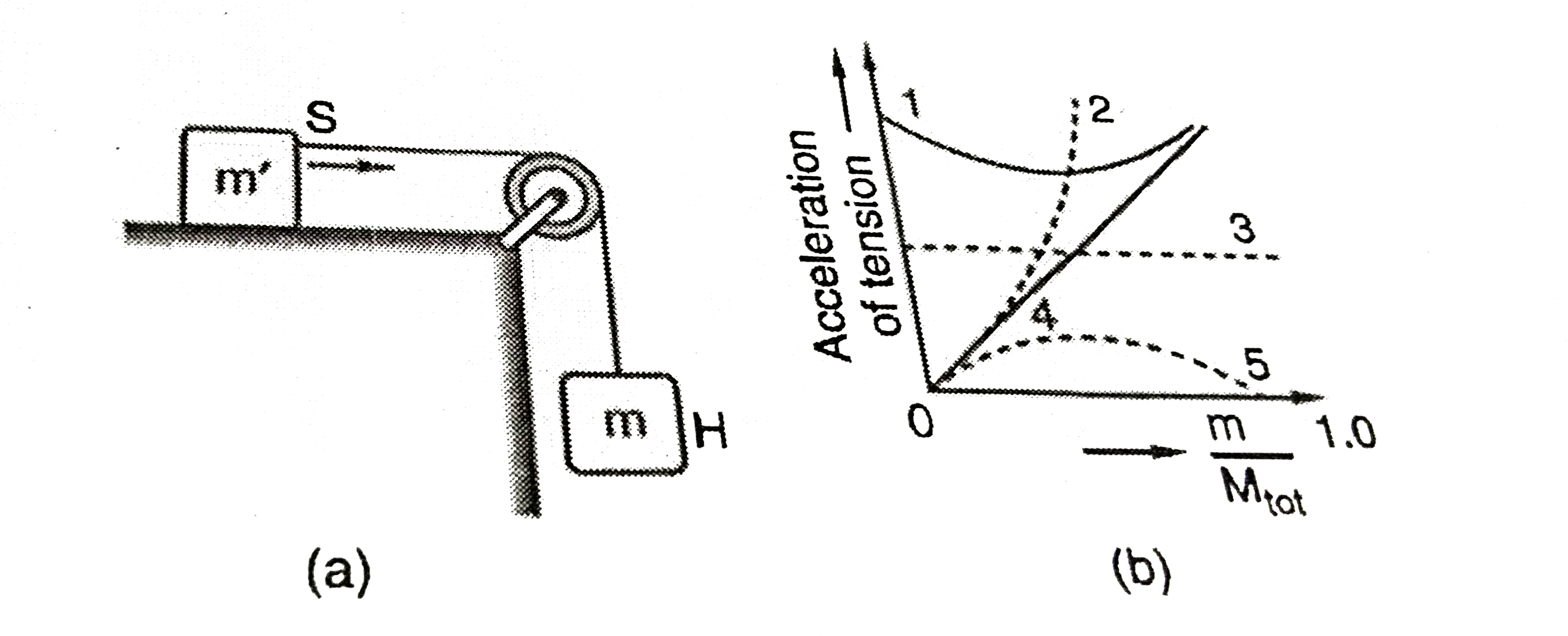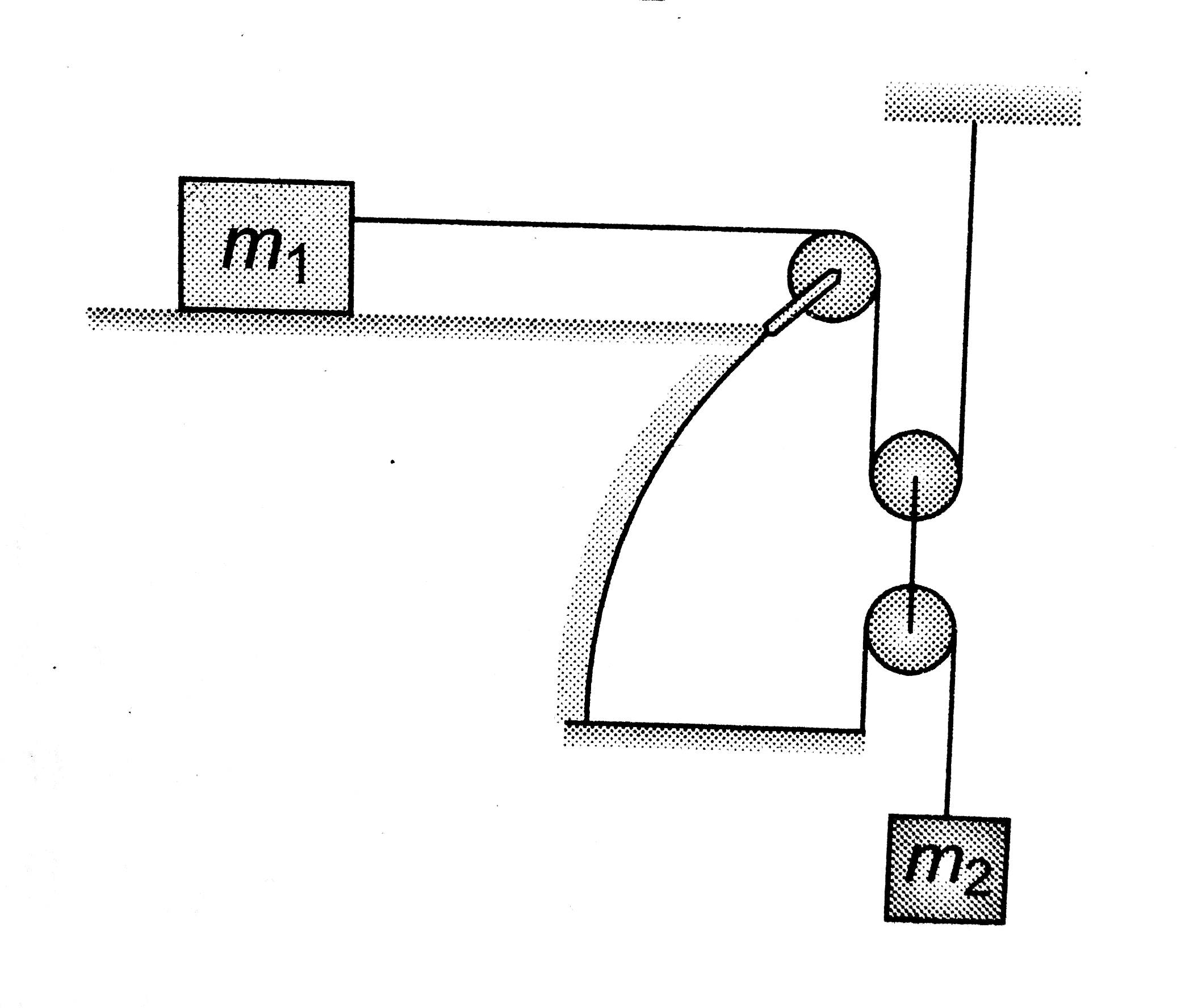Two containers of sand are arranged like the block as shown in fig. the containers alone have negligible mass, the sand in them has a total mass Mtot , the sand in the hanging container H hs mass m.

To measure the magnitude a of the acceleration of the system, a large number of experiments carried out where m varies from experiment to experiment but Mtot does not, that is, sand in shifted between the containers before each trial .

Which of them gives the tension in the connecting cord (vertical axis is for tension) ?
1
2
3
4
The correct Answer is:D
T=M1M2gM1+M2=m(Mtot−m)Mtotg
=(mMtot−m2Mtot)g.
Topper's Solved these Questions
- NEWTON'S LAWS OF MOTION 1Book:CENGAGE PHYSICSChapter:NEWTON'S LAWS OF MOTION 1Exercise:Integer
Explore 5 Videos
- NEWTON'S LAWS OF MOTION 1Book:CENGAGE PHYSICSChapter:NEWTON'S LAWS OF MOTION 1Exercise:Assertion-reasoning
Explore 15 Videos
- MISCELLANEOUS VOLUME 2Book:CENGAGE PHYSICSChapter:MISCELLANEOUS VOLUME 2Exercise:INTEGER_TYPE
Explore 10 Videos
- NEWTON'S LAWS OF MOTION 2Book:CENGAGE PHYSICSChapter:NEWTON'S LAWS OF MOTION 2Exercise:Integer type
Explore 1 Video
Similar Questions
In the Fig. shown, mass 'm' is being pulled on the incline of a wedge of mass M. All the surface are smooth. Find the acceleration of the wedge.

View SolutionIn the arrangement shown in fig the bodies have masses m0,m1andm2 the friction is absent the masses of pulleys and the threads are negligible find the acceleration of the body m1

View Solution
Knowledge Check
Two containers of sand are arranged like the block as shown in fig. the containers alone have negligible mass, the sand in them has a total mass Mtot , the sand in the hanging container H hs mass m.

To measure the magnitude a of the acceleration of the system, a large number of experiments carried out where m varies from experiment to experiment but Mtot does not, that is, sand in shifted between the containers before each trial .

Which of the curves in graph correctly gives acceleration magnitude as a function of the ratio m/Mtot (vertical axis is for acceleration)?A1B2C3D4Two containers of sand S and H are arranged like the blocks figure (a) The container alone have negligible mass, the sand in them has a total mass Mtot , the sand in the hanging container H has mass m. You are to measure the magnitude a of the acceleration of the system in a series of experiments where m varies from experiment to experiment by Mtot does not, that is, you will shift sand between the containers before each trial mMtot is taken on the horizontal axis for all the plots.

The curve which gives tension in the connecting string (taken on y-axis) as a function of ratio (mMtot) is:A1B2C4D5The magnitude of difference in accelerations of block of mass m in both the cases shown below is
 AgB2g3CzeroDg/31
AgB2g3CzeroDg/31
In the arrangement shown in the figure, the blocks have masses 3m,m and 2m, the friction is absent, the masses of the pulleys and the threads are negligible. Find the acceleration of mass 3m.

View Solution
Two blocks of masses m1 and m2 are connected as shown in the figure. The acceleration of the block m2 is :
View SolutionIn the arrangement shown in fig. the block of mass m=2kg lies on the wedge of mass M=8kg. The initial acceleration of the wedge, if the surfaces are smooth, is

View SolutionTwo block of masses m1 and m2 are connected as shown in the figure. The acceleration of the block m2 is:

View SolutionTwo blocks of masses M and m are connected with massless and frictionless pulleys as shown. Strings are also massless. If the magnitude of acceleration of M is a0 then magnitude of acceleration of m is

View Solution

